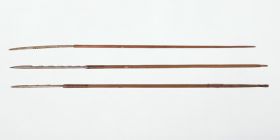Arrows tsee’hatte
Place: Nootka
Category: Fishing & hunting
wood, bone, cherry bark, feather quills, Nootka Sound, northern Pacific, l. 78.1–82.2 cm, Inv. Am 626–628
Cook: Tsee’hatte, Sproat: Tsayhatte
Humphrey No. 322-324: ‘Three short arrows made of Fir, feathered, and pointed with bone barbed at the sides, from ditto [King George’s Sound].’
All three arrows consist of a wooden shaft, with a bone point (with a barb cut out on one side) set in to the front end with a spike. The shaft end is wrapped with cherry bark strips and split feather quills (in the case of Am 628 these have fallen off; the impressions in the wood are still clearly visible). The barbs vary in number, size, and form. Two of the arrows feature rectangular notches at the rear to fit the bowstring; in the case of Am 627 these are also protected by wrapping. The absence of a notch in Am 626 led Haberland (1979: 205) to the conclusion that the piece was a ‘short fish-spear’. In fact, the rear end of the shaft appears to have been broken off at a constriction intended to give a better grip when shooting (Drucker 1951: 32). Only Am 627 exhibits clear traces of a radial feathering by three feathers, which were affixed at three places by bending the feathers forward. Vague impressions of these strings are also recognisable on Am 626, but not on Am 628.
Three of the arrows in |ohn Webber’s collection in Berne (A1 5.2, 5.4, 5.5; Henking 1957: 371-73, Fig. 39; Kaeppler 1978b: 67-69, Fig. 127) are similar to those in Göttingen. Their attribution to Prince William Sound is incorrect.
The written sources on the third voyage mentioned arrows with metal points in addition to those with barbed bone points: ‘Those, who ... live near the Spanish properties, have arrows which are mounted at the front with iron and copper; and presumably, they must also obtain this metal from the Spanish’ (Zimmermann 1981: 79; cf Beaglehole 1967, Illa: 320, 329; Illb: 1101, 1410; Ellis 1783, I: 222). A Siberian iron source and local copper sources are nevertheless more probable origins. Webber depicted arrows in a quiver, out of which only the points projected (Joppien/Smith 1985-88, III/1: 93, PI. 111; II: 453f., 3.2 14f.). Christian F. Feest
Sources
Beaglehole, John Cawte, The Journals of Captain James Cook on his Voyages of Discovery The Voyage of the Resolution and Discovery 1776-1780, Hakluyt Society, Extra Series, 36, 1 u. 2. vol. 3, Cambridge University Press, Cambridge, 1955-1967 IIIa and IIIb.
Drucker, Philip, The Northern and Central Nootka Tribes, Bulletin 144, Bureau of American Ethnology, Smithsonian Institution, Washington, DC, 1951.
Ellis, William, An Authentic Narrative of a Voyage by Captain Cook and Captain Clerke..., [1782], London, 1783.
Haberland, Wolfgang, Donnervogel und Raubwal. Indianische Kunst der Nordwestküste Nordamerikas, Hamburg, 1979.
Henking, Karl H, ‘Die Südsee- und Alaskasammlung Johann Wäber. Beschreibender Katalog’, in Jahrbuch der Bernischen Historischen Museums in Bern, 1957, vols 35-36, pp. 325-389.
Joppien, Rudiger and Smith, Bernard, The Art of Captain Cook’s Voyages, 3 vols in 4 parts, New Haven and London, 1985-1988.
Kaeppler, Adrienne L, Cook Voyage Artifacts in Leningrad, Berne and Florence Museums, Bishop Museum Press, Honolulu, 1978b.
Zimmermann, Heinrich, Reise um die Welt mit Cap. Cook [1781], Insel Taschenbuch 555, Frankfurt a. M. 1981.

